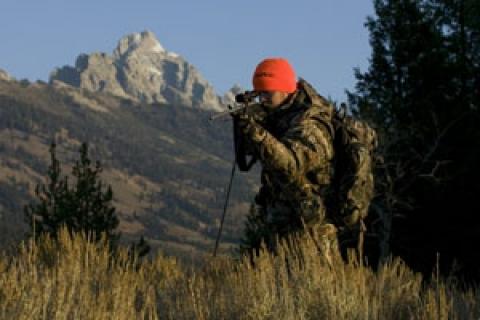
In the Shooting School: Ballistics 101 post, I talked about the rifle and rifle scope used in the Thompson Long Range Shooting School's shooting system. Now let's look at how they're used.
Working Up Handloads to Match Ballistics

a must for long range shooting
success, and a quality chronograph is
the only way to ensure this.
As the system utilizes a Leupold scope with custom reticles calibrated to a particular load, we had to ensure our handloads matched these ballistics. Mark Thompson knows where to start in turns of working up handloads for these rifles, but he does so carefully, watching for signs of excessive pressure.
Using two different chronographs on Mark's indoor range, our handloads were soon producing the desired muzzle velocities, and with the help of an automatic powder measure/dispenser like the Frankford Arsenal scale and dispenser, it wasn't long before we had a box of rounds ready to go, all sporting Nosler's 180-gr Accubond bullets. Off to the outdoor range.
Judging the Wind for Long Range Shooting
Steel shooting targets were set up at ranges from 300 to 1,000 yards. Although not needed for this situation, rangefinders are essential for long range and Mark recommends rangefinding binoculars for hunting, as they're fast and accurate (for more, see Lighten Your Gear Load: The Case for Rangefinding Binoculars). As I located each target through my binoculars, we noted a steady wind blowing and Mark gave me a tutorial on doping the wind.
He's not a believer in windage-compensating reticles, as he feels that judging the wind is always a guess and it's best not to add another uncertainty by possibly using the wrong scope setting. During a quick tutorial on reading the wind using heat mirage, leaves, grass, bugs, dust, etc., I learned that grass and leaves can be less reliable as they tend to sway back and forth, while mirage will flow in just one direction. He's also not a fan of wind meters, as they only show what the wind's doing where you are, not down range.
Bottom line, wind is the enemy so spend time in the field shooting at various distances and judging wind. With a flat-shooting round like the .30-378 Weatherby, it's not usually a factor until you get out to beyond 300 yards.
Finally, It's Time to Shoot
With my first shot from the shooting bench, I banged the gong at 500 yards! Not bad for an Easterner. However, I quickly discovered I have a strong tendency to cant my rifle to the right. Thanks to the anti-cant device that Mark installs on each rifle, I was able to correct for it. At shorter ranges, it wouldn't be a problem, but at 1,000 yards a cant of just 6 degrees (visualized as 1 minute on the face of your watch) moves your bullet 55 inches from point of aim! Although I did miss a couple of shots due to wind as I stretched the range to 800 yards, I soon hit the mark with all 3 shots at 1,000 yards.
If you truly want to shoot at ranges out to 1,000-plus yards, over 3,000 graduates prove that Mark's system works. Even if you just want to improve your shooting at much shorter ranges, it will give you the confidence to do so.
Good hunting
- 4454 views

